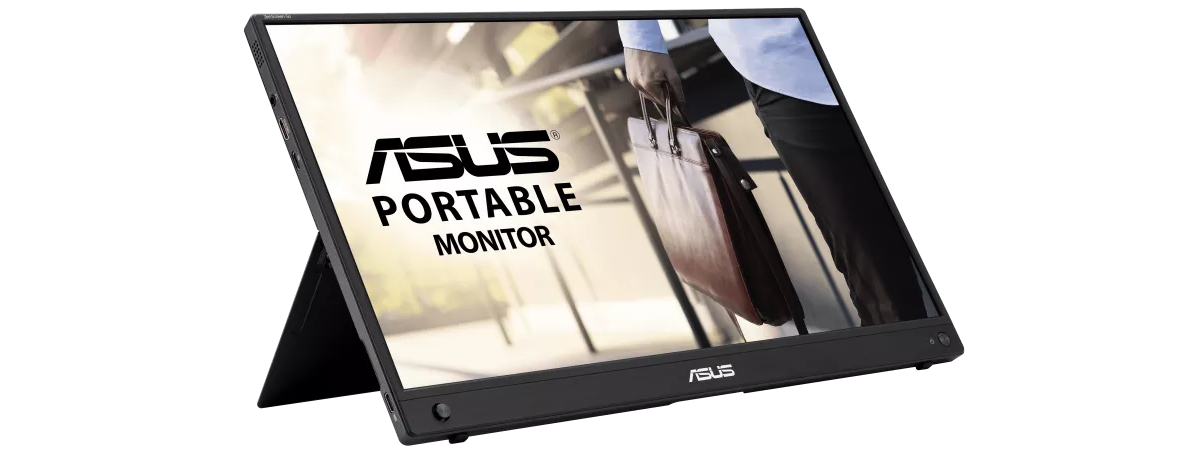
Are you familiar with portable monitors? Did you ever think of getting one? Maybe as a secondary screen for your desktop, or to increase the screen estate while traveling and working remotely on your laptop or tablet? Don’t hold it against me, but until a year or so ago, I didn’t. However, now I’m seriously considering getting a portable monitor, and, as it happens, I’ve recently tested one that I genuinely like: the ASUS ZenScreen Go MB16AWP. Here’s why I think this will be my next acquisition in terms of computing devices and why you might want one too:
NOTE: If you want to read the full review of this portable monitor, you can get to it here: ASUS ZenScreen Go MB16AWP review: A feature-rich portable monitor.
1. The looks, technical specs, and price
I’ll start this article with the things I noticed first about the ASUS ZenScreen Go MB16AWP and the ones that made me want to try it: the way it looks, its technical specifications, and its price. These are all essential details that anyone looks at before deciding to purchase a device. Before I got the ASUS ZenScreen Go MB16AWP, I saw its presentation documents and product images. It looked nice, its recommended price seemed fair, and the technical specs were what I was looking for. Then, when I received, unpacked, and started using it, it proved to be exactly what I wanted. The portable monitor looks great and well built, and besides the embedded stand, it also has a tripod mount on its back. Meaning that you can attach it to any regular tripod to adjust its position on your desk or even place it on a rock while hiking and spending a few days in the mountains. This makes it a great choice if you still have to work while enjoying some “free time” in the great outdoors. 🙂
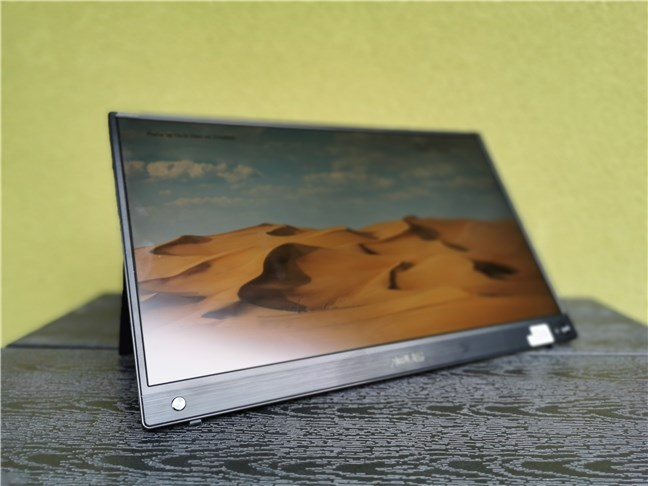
ASUS ZenScreen Go MB16AWP looks nice and has excellent specs
As for the technical specs, ASUS ZenScreen Go MB16AWP has everything you might want from a portable monitor these days. First of all, it’s precisely the size of a laptop display: 15.6 inches in diagonal, with a widescreen aspect ratio, so it fits perfectly next to your laptop if you want a dual-screen setup. Hey, two of them would be even better for those who really need a lot of screen estate. Then, it uses a high-quality 1080p IPS panel with excellent color reproduction, contrast, and viewing angles. It even has a built-in battery that can last for up to four hours on a charge. Last but not least, the ZenScreen Go MB16AWP is as rich as it can be in terms of connectivity options, but more on that in the next section.
2. The connectivity options
The ZenScreen Go MB16AWP can connect to all kinds of devices, which makes it a great choice for people who work with a multitude of gadgets, myself included. It has two physical ports (USB-C and mini HDMI) and wireless connectivity too (Wi-Fi on both 5GHz and 2.4GHz bands). During the time I had to review it, I used this portable monitor with almost all of my devices.
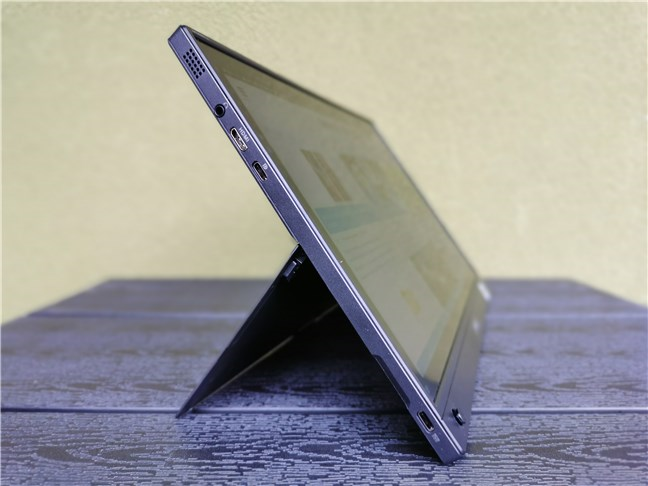
The ASUS ZenScreen Go MB16AWP can connect via USB-C, mini HDMI, and Wi-Fi
I connected it to my desktop PC, laptop, Android tablet, and smartphone, as well as an iPhone. I used mini HDMI and USB-C connections, as well as wireless projection, and the monitor worked great each time. All types of connections were fast and established without any issues, and never have I encountered random disconnects, as I did with some other portable monitors I tested in the past. This, together with the fact that you can practically use it with any kind of device, makes me genuinely happy, and I’m sure it will make a great addition to anyone’s computing toolbox.
3. The ease of use
The ASUS ZenScreen Go MB16AWP offers a simple and intuitive OSD menu and a similarly uncomplicated web interface. For regular adjustments and settings, like brightness, contrast, or color, the on-screen menu is what you need. And it’s easy to use it: the monitor’s joystick makes navigating the menu elementary, while the menu itself is well organized and doesn’t come with setting names that are difficult to comprehend.
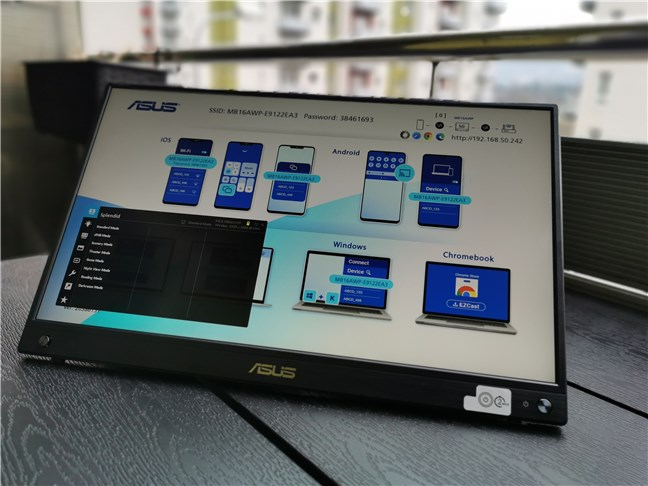
OSD menu and Wi-Fi details shown on the ASUS ZenScreen Go MB16AWP
Furthermore, the web interface is just as easy to access, navigate and understand. When on standby, the portable monitor shows you its network name, password, and IP address. All you have to do is connect to its Wi-Fi and use any web browser to go to the monitor’s IP address. Then, you can connect the ASUS ZenScreen Go MB16AWP to your home network, upgrade its firmware, change its Wi-Fi name and password, etc. It’s really easy!
4. The remarkable versatility as a portable monitor
To be honest, when I see a portable monitor, I usually think of it as a possible extension to my screen space in terms of work. A secondary monitor represents a good way of increasing the screen estate, especially when I use my laptop, providing a much-needed additional space for the windows and apps I need to check regularly but are not my main focus - like Slack, WhatsApp, or Asana. I like having them in the corner of my eye, always being online and on top of what’s happening. The ASUS ZenScreen Go MB16AWP did just that for me, and I found it especially useful when I traveled and worked remotely.
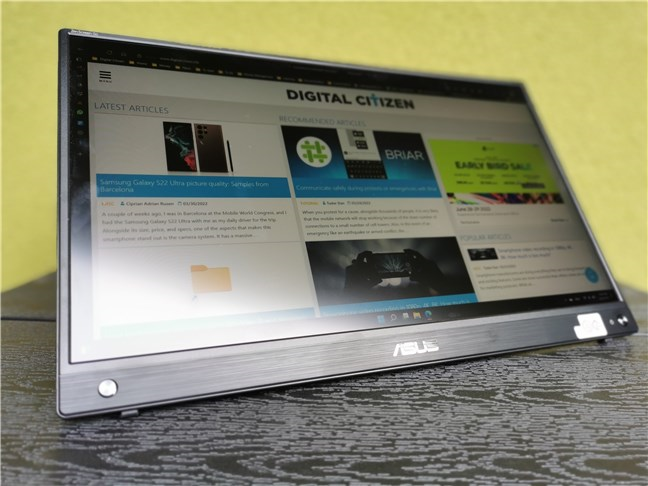
The ASUS ZenScreen Go MB16AWP is an excellent choice for a secondary screen
And although I’m into writing, I can see how a portable monitor like this one can be of great service to other types of professionals. For example, if you’re a software or web developer, a portable monitor is what you probably want when you’re working away from home, either to preview your code or for documentation. Or, similarly, if you’re a designer or a videographer, you’re likely using apps that demand a lot of screen estate for their interfaces. It’s only natural, as such programs usually have many features, options, settings, timelines, etc. In this case, a portable monitor is, in my mind, a must-have for when you’re working remotely.
What are you looking for in your next portable monitor?
Now you know why I’m thinking of buying the ASUS ZenScreen Go MB16AWP. I find it to be exactly what I want, both in terms of looks, features, and specs. Yet, I’m curious: what do you want from a portable monitor? What will make you say: “Yes, this is the one I want, and these are the reasons why I want it!”? Let me know in the comments section below.



 11.04.2022
11.04.2022 

